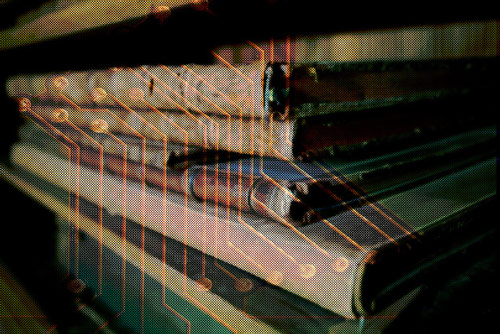This past fall term, I took both Editorial Theory and Concepts in Digital Publishing. Editorial Theory mainly dealt with the divergent (read: ideologically fraught) theoretical principles underlying the creation of critical editions—that is, “authoritative” versions of works the academy has deemed worthy of scholarly editorial treatment. Research into the genesis and development of the work in question is the basis of any critical edition. Yes—surprise! Works of literature don’t just pop into existence; they develop before and even after they are first published, and many people besides the author (think editor, publisher, Ezra Pound, your not-quite-sober typesetter) have a hand in whether the hero dies or not, whether I love or adore you, or whether this very sentence ends in an excited exclamation point or a dignified and unassuming period. (Period it is!)

One work, different versions.
To illustrate what scholarly editors are dealing with in a simplified way, this little table displays, along the x-axis, five static, self-contained iterations of the text. They stretch along a y-axis, however; that is, the overall work is in an ongoing process of development, in a state of flux.
Scholarly editors are confronted, then, with a question of representation: how do they create an edition that accounts fully for the text’s multidimensionality? Traditionally, editors in the Anglo-American context have created so-called eclectic editions that “flatten” the work into one clear reading text and note the variations between text versions in sprawling footnotes and/or appendixes (yeah, you know the ones). This usually results in a text that has never before existed—the editor picked one word from the manuscript, the next word from the first edition, and so on. The German-inflected Continental school of critical editing has traditionally put more emphasis on representing the development of the work over time and has devised intricate ways of representing several text versions at once.
 .
.
Recto page of Jeffrey S. Cramer’s 2004 edition of Walden, an eclectic edition with a clear reading text on the left and notes on the right.

Hans Zeller’s 1975 representation of the textual history of C.F. Meyer’s poem “Der Rappe des Comturs” closely echoes my hypothetical table at the beginning of this post.

Hans Walter Gabler devised a system of diacritical marks to represent Joyce’s continuous writing process in his 1984 edition of Ulysses.
The drawbacks of both schools’ preferred modes of representing the work quickly become apparent. The eclectic edition, in presenting the reader with a clear reading text, conceals the work’s multidimensionality—it represents the work as a static, choate entity. The historical edition, conversely, sacrifices readability for a representation of the work’s multidimensionality, thereby making it accessible to a highly specialized readership with a decidedly academic interest in the text only.
Because I was also taking Concepts in Digital Publishing, I soon became convinced that the limitations of both the eclectic and the historical edition are, to a great extent, conditioned by the materiality of the printed book format. Ink on paper inevitably inscribes a static text.
Cut to today, to now, to our brave new World Wide Web, to hypertext, which certainly has the potential to accommodate complex textual relationships. Where are the digital critical editions? Editions that offer their reader-users accessible texts, layered presentations of text versions, critical commentary that can be toggled on and off? Editions that are responsive to their readers’ needs?
The reality, as far as I can see, is that most online scholarly projects are repositories, databases of raw material more or less curated, or digital editions (without the “critical”). Don’t get me wrong—projects like Folger Digital Texts are immensely valuable resources (for their searchability alone), but they don’t account for the multidimensionality of the work(s) they contain.
The one single digital edition I have come across thus far that best makes use of the digital environment is the Digital Thoreau’s fluid-text edition of Walden, which first went online in February 2014. It allows readers to display seven stages of Thoreau’s manuscript alongside the standard print critical edition of Walden and to track passages throughout their development. It is critically annotated, and its intuitive user interface ensures that it’s accessible to general and scholarly readers alike. In the future, the project’s creators plan to add manuscript facsimiles.
The Digital Thoreau provides a promising model for future developments that might succeed in overcoming the problems of representation inherent to printed critical editions. The digital humanities have made huge strides in the past few decades, yet there is still a scarcity of digital critical editions. Here is a huge chance for universities, scholars, programmers, and publishers to set an example by fully exploiting the advantages of the digital environment.

